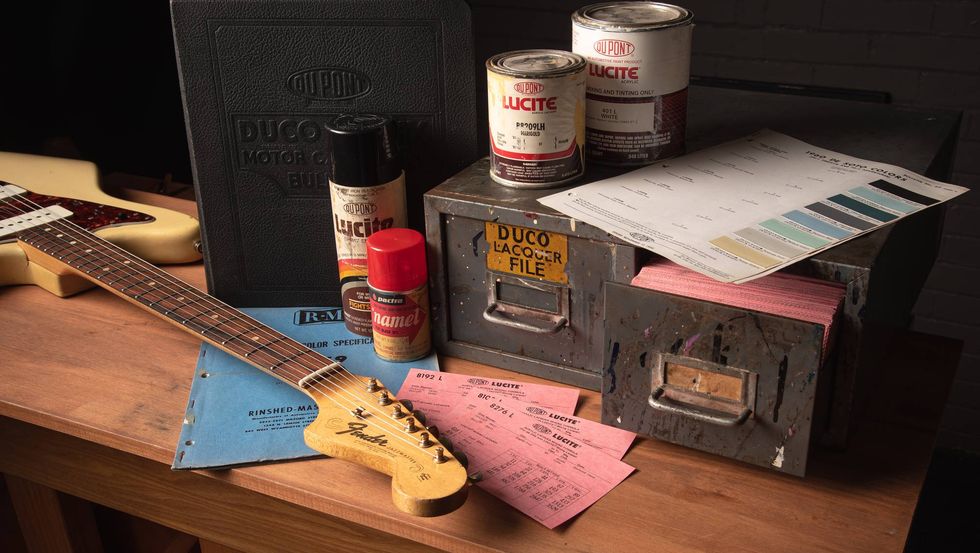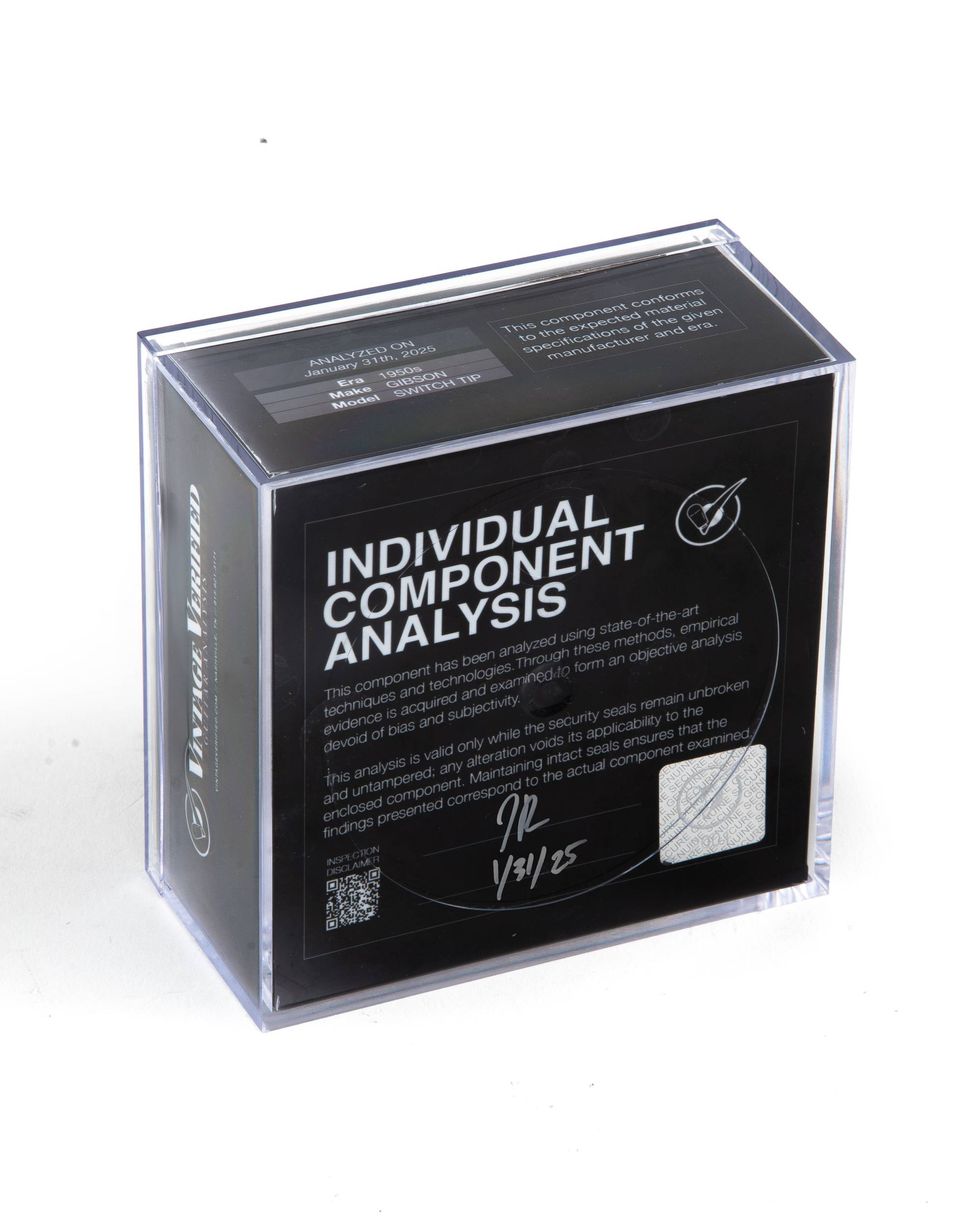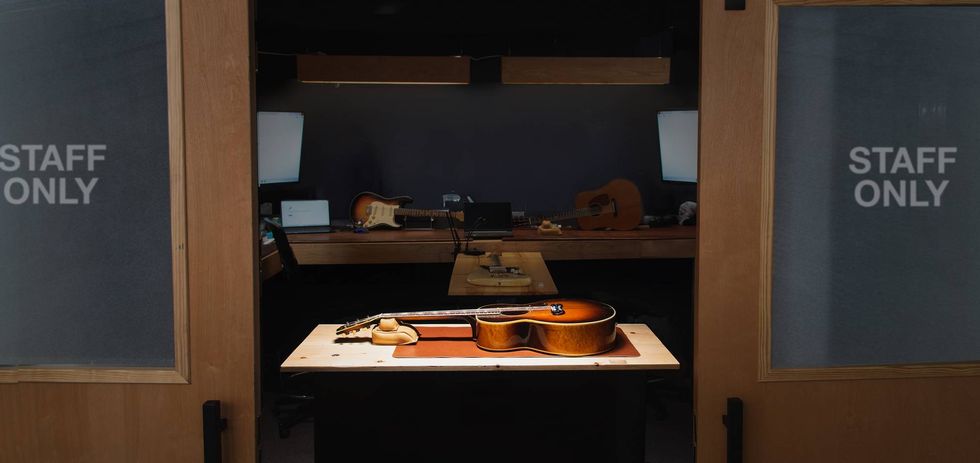| Download Example 1 Classic American Clean | |
| Download Example 2 British Crunch | |
| Download Example 3 Class A Chime | |
| Download Example 4 Modern High-Gain | |
| Clips recorded with a Gibson 1960 Les Paul Historic. Line 6 DT50 112 amplifier miked with a Shure SM57 into an ART Tubeamp Studio preamp into Garage Band. | |
One of the biggest gripes among amp-modeling skeptics over the years has been the lack of realistic power-tube feel and response in modeling amps. So, in 2007, Line 6 collaborated with legendary tube-amp guru Reinhold Bogner to introduce the Spider Valve amp line, which married Bogner-designed 6L6-based tube circuitry to Line 6’s amp modeling and digital effects programs. Now, Line 6 has introduced the new DT50 line of 50-watt, two-channel amps co-designed by Bogner. Without scores of onboard digital effects, the DT50s ostensibly offer a simpler path to classic, authentic tube tones, response, and feel—everything from clean Fender and Vox flavors to high-gain Marshall tones. We were lucky enough to have a turn with the most basic version in the line, the DT50 1x12 combo.
Deceptively Traditional
Removing the DT50 112 from its shipping box involved a small struggle, because this thing leans a bit toward the heavy side. But I soon found its bulk translates to big tones, too. That’s because the cabinet is pretty big for a 1x12 amplifier. At about 22" x 26" x 10 1/2", it’s roughly the size of a 2x12 Fender Twin Reverb. And it’s built like a rock and feels exceptionally road ready, too. (Line 6’s Marc Block responds, “This is what one might call an oversized 1x12, which greatly contributes to the big tones. Players have consistently commented on the fact that this sounds so much larger than a 1x12. What the user gets in trade for a relatively large 1x12 combo is a sound that begins to approach the girth of a 4x12 cab—especially when paired with voicing IV. The weight is actually 63.1 pounds, which is commensurate with the lightest Twins but lighter than the heavier Twins— and an AC30 is over 70 pounds.”)
With its black vinyl covering and generally unadorned appearance, the DT50 has an appealingly traditional look compared to some of the more radically styled Line 6 amps. A peek inside the back reveals other old-fashioned elements, too: pairs of 12AX7 preamp and EL34 power tubes, along with a Celestion 12" speaker.
Operating the DT50 is simple enough on the surface. You plug directly into a High (for standard-level guitars) or Low (for high-output pickups) input and fire it up. Each channel’s knobs are arranged in a horizontal configuration with familiar controls for Volume, Bass, Mid, Treble, Presence, Reverb, and Volume. However, the outward simplicity of the DT50 belies some very sophisticated capabilities. The amp has four topologies that are selectable via a frontpanel toggle. Each has an entirely different basic voice. Topology I is classic American clean (like a 1960s blackface Fender), II serves up British crunch similar to a Marshall, III offers Vox-like class-A chime, and IV proffers modern gain patterned after a Mesa/Boogie or Bogner.
One of the more interesting things that may impress even hardcore modeling skeptics is that switching between the topologies changes both the amp’s tube and digital modeling configurations: When you switch between them you can actually hear a little click as the analog parts move inside. What’s doubly cool is that you can assign any voicing to either channel—or even the same one to both channels. For instance, you could assign voicing IV to both channels and fine-tune the individual channels to switch between gritty and grittier sounds, or apply voicing I to one channel and voicing III to the other and switch between classic Fender-y and Vox-ish clean tones.
Another feature that distinguishes the DT50 from other modeling amps is the ability to switch between class A and class AB and pentode or triode power-tube operation—for each channel. And, again, all of this involves instant reconfigurations of the analog power section, which is completely independent of the modeling side of things. Just as you’d expect, class A feels more responsive and breaks up earlier, while class AB offers more clean headroom. Similarly, pentode mode offers a powerful, clear, more modern sound, whereas triode mode sounds smoother and rounder for a more vintage-type tone.
The channels can be switched via the front-panel toggle or a standard footswitch with a 1/4" plug (not included). The fact that each channel also remembers its last topology— including the class and Pentode/Triode settings—is very convenient.
Adding to its convenience and flexibility, the DT50 also has a low-volume mode intended for small clubs or late-night practicing. This is activated by pulling out the Master Volume knob. At low volumes in this mode, the digital processor is responsible for a large percentage of the tone, but as you turn up the volume the analog components increasingly take over—which translates to more enjoyable tone as you increase the dBs.
Other features include MIDI input and output jacks, a cabinet-simulating XLR direct out for recording without having to mic the amp, a serial effects loop with a Level knob, and dual-XLR L6 Link jacks for connecting to any of Line 6’s POD HD multi-effects processors. One advantage of the latter is that you can pair any POD HD preset with the DT50’s analog components to avail yourself of a lot more than just four tones.
Everything Is Illuminated
To test the DT50, I used a 1960 Gibson Les Paul Historic. When I switched on the DT50, I was pleasantly surprised to see that each control’s label was illuminated—which is definitely handy when you’re playing on a dark stage. It also eased my apprehension about navigating a fairly busy control panel. Thankfully, the DT50 comes with a handy removable reference sheet that logically details the different functions.
Being a big blackface fan, I first tried Topology I, the classic American clean sound. While the DT50 didn’t quite have the intangible magic of an old Fender Deluxe Reverb, it was thick, warm, and spongy—and the springreverb modeling sounded quite realistic.
The other three topologies—crunch (II), bright clean (III), and high-gain (IV)—were strikingly distinctive. Crunch mode, with its touch-sensitive bark, was particularly inspiring. The bright clean sound was appropriately jangly, but could also be a hair strident. Switching to the high-gain setting almost resulted in a Back to the Future moment—like the scene where one chord from a giant stack propels Marty McFly across a room. (Note to self: Always lower the Master Volume when switching between topologies.) With the volume adjusted, the high-gain voicing was appropriately pulverizing. On all of the voicings, the amp was least dynamic in low-volume mode, but this is often true even of classic all-tube designs. And this mode still provides a great tone for practicing.
The Verdict
The Line 6 DT50 112 is a smart new amp that successfully merges valve power and modeling technology. It offers a wide assortment of usable tones in a single package, as well as the capacity to communicate with external gear for impressive flexibility. While the DT50 won’t necessarily replace a fine collection of vintage valve amps, it costs a fraction of the price of said collection, sounds great in its own right, and would excel in almost any performance situation.
Buy if...
tube amps are your first love but you need a broad tonal palette and a lot of flexibility in one amp.
Skip if...
you’ve got a studio full of old tube amps and don’t play out much.
Rating...
Street $1299 - Line 6 - line6.com |









![Rig Rundown: John 5 [2026]](https://www.premierguitar.com/media-library/youtube.jpg?id=62681883&width=1245&height=700&quality=70&coordinates=0%2C45%2C0%2C45)









![Rig Rundown: Russian Circles’ Mike Sullivan [2025]](https://www.premierguitar.com/media-library/youtube.jpg?id=62303631&width=1245&height=700&quality=70&coordinates=0%2C0%2C0%2C0)







